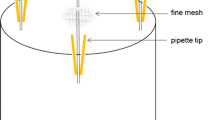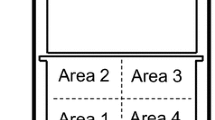Summary
Sugar intake rates of captive Australian honeyeaters (Meliphagidae) feeding at artificial flowers varied across species, and as a function of nectar volume and concentration within each species. Red Wattlebirds (Anthochaera carunculata, 110 g), achieved higher intake rates than New Holland Honeyeaters (Phylidonyris novaehollandiae, 20 g), and both achieved higher rates than Eastern Spinebills (Acanthorhynchus tenuirostris, 10 g). These results reflect differences in bill and tongue dimensions as well as in body mass. Sugar intake rates for all three species increased with volume (5–50 μl) at any given concentration (10–60% mass/mass sucrose). For a given volume, sugar intake rates peaked at intermediate concentrations: 40–50% for the two larger species, and 30–40% for the smallest species. Published studies for other nectarivores foraging at unlimited volume feeders also show optimal nectar concentrations of 30–50%. However, biophysical theory predicts optima at 20–26% for small volumes, and plants presumed to be adapted for bird-pollination often have dilute nectar (20–30%). To explore this discrepancy further, we presented New Holland Honeyeaters with a range of sucrose concentrations (10–50%) using two presentation schemes. In the first we varied concentration but kept volume constant, thus varying gross sugar reward available in each concentration. This gave maximum sugar intake rates at 50%. In the second we varied both volume and concentration so that gross sugar rewards were equal for all solutions, decoupling high concentrations and large sugar rewards. This gave optima at 20%. We argue that variation among plants in nature more closely resembles the latter, “equal sugar presentation” scheme, and therefore, that dilute nectars may indeed represent adaptations for bird pollination.
Similar content being viewed by others
References
Baker HG (1975) Sugar concentrations in nectars from humming-bird flowers. Biotropica 7:37–41
Baker HG, Baker I (1983) Floral nectar sugar constituents in relation to pollinator type. In: CE Jones Little RA (eds) Handbook of Experimental Pollination Biology. Van Nostrand Reinhold, New York, pp 117–141
Boggs CL (1988) Rates of nectar feeding in butterflies: effects of sex, size, age and nectar concentration. Funct Ecol 2:289–295
Bolten AB, Feinsinger P (1978) Why do hummingbird flowers secrete dilute nectar? Biotropica 10:307–309
Bolten AB, Feinsinger P, Baker HG, Baker I (1979) On the calculation of sugar concentration in flower nectar. Oecologia 41:301–304
Cibula DA, Zimmerman M (1987) Bumblebee foraging behavior: change in departure decisions as a function of experimental nectar manipulations. Am Midl Nat 117:386–394
Collins BG, Paton DC (1989) Consequences of differences in body size, wing length and leg morphology for nectar-feeding birds. Aust J Ecol 14:269–289
Dawson RMC, Elliott DC, Eliott WH, Jones KM (1969) Data for biochemical research. Oxford University Press, Oxford, UK
Faegri K, van der Pijl L (1971) The Principles of Pollination Ecology. 2nd revised ed. Pergamon, Oxford
Feinsinger P (1978) Ecological interactions between plants and hummingbirds in a successional tropical community. Ecol Monogr 48:269–287
Ford HA (1976) The honeyeaters of Kangaroo Island. South Aust Ornithol 27:199–203
Ford HA (1979) Interspecific competition in Australian honeyeaters — depletion of common resources. Aust J Ecol 4:145–164
Ford HA, Paton DC (1977) The comparative ecology of ten species of honeyeaters in South Australia. Aust J Ecol 2:399–407
Ford HA, Paton DC, Forde N (1979) Birds as pollinators of Australian plants. NZJ Bot 17:509–519
Ford HA, Pursey JF (1982) Status and feeding of the Eastern Spinebill Acanthorhynchus tenuirostris at at New England National Park, north-eastern NSW. Emu 82:203–211
Galen C, Plowright RC (1985) The effects of nectar level on pollen carryover in inflorescences of fireweed (Epilobium angustifolium; Onagraceae). Can J Bot 63:488–491
Gass CL, Sutherland GD (1985) Specialization by territorial hummingbirds on experimentally enriched patches of flowers: energetic profitability and learning. Can J Zool 163:2115–2124
Hainsworth FR (1973) On the tongue of a hummingbird: its role in the rate and energetics of feeding. Comp Biochem Physiol 46A:65–78
Hainsworth FR, Wolf LL (1976) Nectar characteristics and food selection by hummingbirds. Oecologia 25:101–113
Harder LD (1983) Flower handling efficiency of bumble bees: morphological aspects of handling time. Oecologia 57:274–280
Harder LD (1986) Effects of nectar concentration and corolla depth on flower handling efficiency of bumble bees. Oecologia 69:309–319
Harder LD, Real LA (1987) Why are bumble bees risk averse? Ecology 68:1104–1108
Heinrich B, Raven PH (1972) Energetics and pollination ecology. Science 176:597–602
Heyneman AJ (1983) Optimal sugar concentrations of floral nectars-dependence on sugar intake efficiency and foraging costs. Oecologia 60:198–213
Hodges CM (1981) Optimal foraging by bumblebees: hunting by expectation. Behaviour 29:1166–1171
Hodges CM, Wolf LL (1981) Optimal foraging in bumblebees. Why is nectar left behind in flowers? Behav Ecol Sociobiol 9:41–44
Hopper SD, Burdidge AH (1986) Speciation of bird-pollinated plants in South-Western Australia. In: Ford HA, Paton DC (eds) The dynamic partnership: birds and plants in southern Australia. South Australian Government printer, Adelaide, pp 20–31
Keighery GJ (1982) Bird-pollinated plants in Western Australia. In: J.A. Armstrong, J.M. Powell, A.J. Richards (eds) Pollination and Evolution. Royal Botanic Gardens, Sydney, pp 77–89
Kingsolver JG, Daniel TL (1979) On the mechanics and energetics of nectar feeding in butterflies. J Theor Biol 76:167–179
Kingsolver JG, Daniel TL (1983) Mechanical determinants of nectar feeding strategies in hummingbirds: energetics, tongue morphology and licking behavior. Oecologia 60:214–226
May PG (1985) Nectar uptake rates and optimal nectar concentrations of two butterfly species. Oecologia 66:381–386
Montgomerie RD (1985) Nectar extraction by hummingbirds: response to different floral characters. Oecologia 63:229–236
Montgomerie RD, McA Eadie J, Harder LD (1985) What do foraging hummingbirds maximize? Oecologia 63:357–363
Paton DC (1979) The behaviour and feeding ecology of the New Holland honeyeater Phylidonyris novaehollandiae in Victoria. PhD thesis, Monash University, Melbourne
Paton DC (1982a) The diet of the New Holland Honeyeater Phylidonyris novaehollandiae. Aust J Ecol 7:279–298
Paton DC (1982b) The influence of honeyeaters on flowering strategies of Australian plants. In: JA Armstrong, JM Powell, AJ Richards (eds) Pollination and Evolution. Royal Botanic Gardens, Sydney, pp 95–108
Paton DC (1985) Food supply, population structure, and behaviour of New Holland Honeyeaters Phylidonyris novaehollandiae in a woodland near Horsham, Victoria. In: A Keast, HF Recher, HA Ford, DA Saunders (eds) Birds of Eucalypt forests and woodlands: ecology, conservation, management. Surrey Beatty and Sons, Sydney, pp 219–230
Paton DC (1986) Honeyeaters and their plants in south-eastern Australia. In: Ford HA, Paton DC (eds) The Dynamic Partnership: Birds and Plants in Southern Australia. SA Government Printer, Adelaide, pp 9–19
Paton DC (1988) Interdependence of Australian honeyeaters (Meliphagidae) and nectar-producing plants. Acta XIX Congressus Internationalis Ornithologius. Univ of Ottawa Prep, Ottawa, Canada, pp 549–559
Paton DC, Collins BG (1990) Bills and tongues of nectar-feeding birds: a review of morphology, function and performance, with intercontinental comparisons. Aust J Ecol (in press)
Paton DC, Ford HA (1977) Pollination by birds in some native plants in South Australia. Emu 77:73–85
Paton DC, Ford HA (1983) The influence of plant characteristics and honeyeater size on levels of pollination in Australian plants. In: Jones CE, Little RA (eds) Handbook of Experimental Pollination Biology. Van Nostrand Reinhold, New York, pp 235–248
Pivnick KA, McNeil JN (1985) Effects of nectar concentration on butterfly feeding: measured feeding rates for Thymelicus lineola (Lepidoptera: hesperiidae) and a general feeding model for adult lepidoptera. Oecologia 66:226–237
Pleasants JM (1981) Bumblebee response to variation in nectar availability. Ecology 62:1648–1661
Pyke GH (1978) Optimal foraging in hummingbirds: testing the marginal value theorem. Am Zool 18:739–752
Pyke GH (1980) The foraging behaviour of Australian honeyeaters: a review and some comparisons with hummingbirds. Aust J Ecol 5:343–369
Pyke GH (1981a) Optimal nectar production in a hummingbird pollinated plant. Theor Pop Biol 20:326–343
Pyke GH (1981b) Hummingbird foraging on artificial inflorescences. Behav Anal Lett 1:11–15
Pyke GH (1981c) Honeyeater foraging: a test of optimal foraging theory. Behaviour 29:878–888
Pyke GH (1984) Optimal foraging theory: a critical review. Ann Rev Ecol Syst 15:523–575
Pyke GH, Waser NM (1981) The production of dilute nectars by hummingbird and honeyeater flowers. Biotropica 13:260–270
SAS Institute Inc (1982) Sas User's Guide: Basics, 1982 Edition. Cary NC: SAS Institute Inc, USA
Schmid-Hempel P, Kacelnik A, Houston AI (1985) Honeybees maximise efficiency by not filling their crop. Behav Ecol Sociobiol 17:61–66
Simpson BB, Neff JL (1983) Evolution and diversity of floral rewards. In: Jones CE, Little RA (eds) Handbook of Experimental Pollination Biology. Van Nostrand Reinhold, New York, pp 142–159
Sokal RR, Rohlf FJ (1981) Biometry. WH Freeman, New York
Stephens DW, Krebs JR (1986) Foraging Theory. Princeton University Press, Princeton, New Jersey
Stiles FG (1976) Taste preferences color preferences and flower choice in hummingbirds. Condor 78:10–36
Tamm S (1989) Importance of energy costs in central place foraging by hummingbirds. Ecology 70:195–205
Tamm S, Gass CL (1986) Energy intake rates and nectar concentration preferences by hummingbirds. Oecologia 70:20–23
Thomson JD (1986) Pollen transport and deposition by bumble bees in Erythronium: influences of floral nectar and bee grooming. J Ecol 74:329–341
Thomson JD, Plowright RC (1980) Pollen carry-over, nectar rewards, and pollinator behavior with special reference to Diervilla lonicera. Oecologia 46:68–74
Waddington KD (1981) Factors influencing pollen flow in bumblebee-pollinated Delphinium virescens. Oikos 37:153–159
Waller GD (1972) Evaluating responses of honey bees to sugar solutions using an artificial-flower feeder. Ann Entomol Soc Am 65:857–862
Waser NM (1983) The adaptive nature of floral traits: ideas and evidence. In: Real L (ed) Pollination Biology. Academic Press, London, pp 242–277
Whitham TG (1977) Coevolution of foraging in Bombus and nectar dispensing in Chilopsis: a last dreg theory. Science 197:593–596
Winer BJ (1971) Statistical principles in experimental design. Second edition. McGraw-Hill, New York
Woodrow AW (1968) Some factors affecting selection of sucrose solutions by foraging honey bees. Am Bee J 108:313–315
Wyatt R, Shannon TR (1986) Nectar production and pollination of Asclepias exaltata. Syst Bot 11:326–334
Zimmerman M (1983) Plant reproduction and optimal foraging: experimental nectar manipulations in Delphinium nelsonii. Oikos 41:57–63
Author information
Authors and Affiliations
Rights and permissions
About this article
Cite this article
Mitchell, R.J., Paton, D.C. Effects of nectar volume and concentration on sugar intake rates of Australian honeyeaters (Meliphagidae). Oecologia 83, 238–246 (1990). https://doi.org/10.1007/BF00317758
Received:
Accepted:
Issue Date:
DOI: https://doi.org/10.1007/BF00317758




